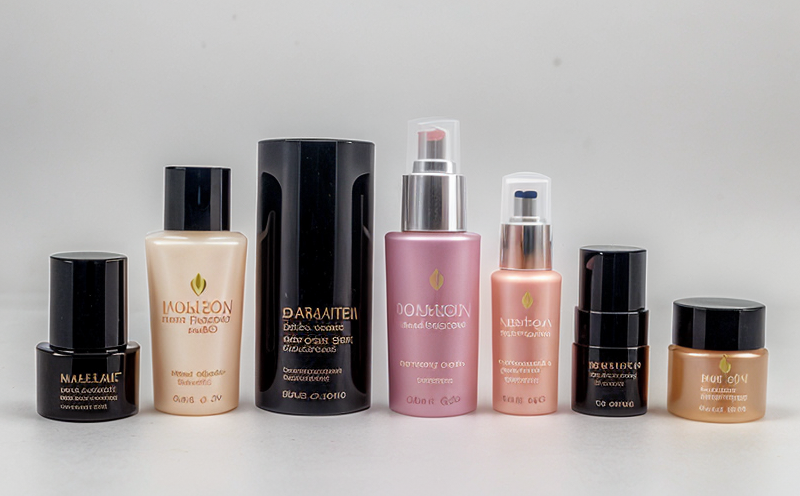Chemical Resistance Testing of Packaging for Cosmetics
The chemical resistance testing of packaging for cosmetics is a critical process in ensuring the integrity and safety of cosmetic products. This service involves evaluating how different chemicals, solvents, and ingredients interact with the packaging material. The goal is to prevent any potential leaching or migration that could impact product quality and consumer health.
In the beauty industry, compliance with international standards such as ISO 16895:2004 for cosmetic packaging materials is essential. This standard ensures that packaging does not release harmful substances into the product under normal conditions of use and storage. The testing process typically involves placing samples in contact with various solvents or chemicals to observe any interaction.
The test setup can vary depending on the specific requirements, but it often includes immersion tests where the packaging is submerged in a solvent for an extended period. Additionally, vapor phase testing may be conducted to assess whether volatile compounds from the product migrate through the packaging material into the air or other containers.
For quality managers and compliance officers, understanding these tests can help ensure that products meet regulatory requirements both domestically and internationally. R&D engineers benefit from this service as they develop new formulations and package designs. Proper chemical resistance testing ensures that any changes in formula do not compromise packaging integrity or safety.
This process is particularly important for ensuring the stability of active ingredients within cosmetic products. For instance, certain preservatives might degrade if exposed to specific chemicals present in the packaging material. By conducting thorough chemical resistance tests, manufacturers can identify potential issues early on and make necessary adjustments before product launch.
Furthermore, this service plays a crucial role in protecting consumers from harmful substances that could leach into their products due to improper packaging design. Proper testing helps maintain the efficacy of cosmetic formulations while ensuring consumer safety.
The importance of chemical resistance testing cannot be overstated, especially considering the increasing demand for environmentally friendly packaging solutions. Ensuring that these materials remain intact throughout product lifecycle can significantly reduce waste and promote sustainability practices within the industry.
Why It Matters
The significance of chemical resistance testing cannot be overstated, as it directly impacts both consumer safety and brand reputation. When packaging interacts improperly with cosmetic products, it can lead to contamination or degradation of active ingredients. This not only affects the product's efficacy but also poses health risks for users.
- Prevents Contamination: Proper chemical resistance testing ensures that no harmful substances from the packaging migrate into the cosmetics during storage and use.
- Maintains Efficacy: Ensures that active ingredients remain stable throughout their shelf life, preserving the product's intended benefits for consumers.
- Enhances Brand Reputation: Consistent quality through rigorous testing builds trust with customers and protects brand integrity.
In addition to these factors, understanding how different chemicals interact with packaging materials helps companies make informed decisions about material selection. By choosing appropriate materials that show good chemical resistance properties, manufacturers can extend the shelf life of their products while minimizing waste generation.
For regulatory compliance, meeting industry standards like ISO 16895:2004 ensures that packages are safe for consumer use and comply with relevant regulations globally. This not only reduces legal risks but also facilitates smoother market entry into various countries.
Applied Standards
The chemical resistance testing of packaging for cosmetics is governed by several international standards designed to ensure product safety and integrity. One of the key standards used in this field is ISO 16895:2004, which provides guidelines on the chemical compatibility between packaging materials and cosmetic products.
Under ISO 16895, different types of tests are conducted depending on the nature of the product and its intended contact with the packaging. For instance:
- Vapor Phase Migration Tests: These assess whether volatile compounds from the cosmetic migrate through the packaging material into surrounding areas.
- Solvent Immersion Tests: Samples are immersed in various solvents to evaluate their resistance against chemical interactions.
Besides ISO 16895, other relevant standards include ASTM D2347-04(2016), which specifies methods for determining the migration of organic substances from plastic containers into aqueous systems. These tests are essential in ensuring that packaging materials do not release harmful chemicals into cosmetic products.
By adhering to these international standards, manufacturers demonstrate their commitment to producing safe and reliable cosmetic products that meet global regulatory requirements.
Benefits
- Promotes Product Safety: Ensures that no harmful substances migrate from the packaging into the cosmetic product, protecting consumers' health.
- Maintains Efficacy: Preserves active ingredients within the cosmetics, ensuring they remain effective throughout their shelf life.
- Enhances Brand Reputation: Demonstrates a commitment to quality and safety, enhancing brand trust and loyalty among customers.
- Avoids Regulatory Penalties: Ensures compliance with international standards like ISO 16895:2004, reducing the risk of legal issues.
- Fosters Sustainable Practices: By selecting appropriate packaging materials that show good chemical resistance properties, companies can reduce waste and promote sustainability within the industry.
In addition to these benefits, chemical resistance testing also helps manufacturers identify potential problems early in the development process. This allows them to make necessary adjustments before product launch, saving time and resources while ensuring high-quality final products.





